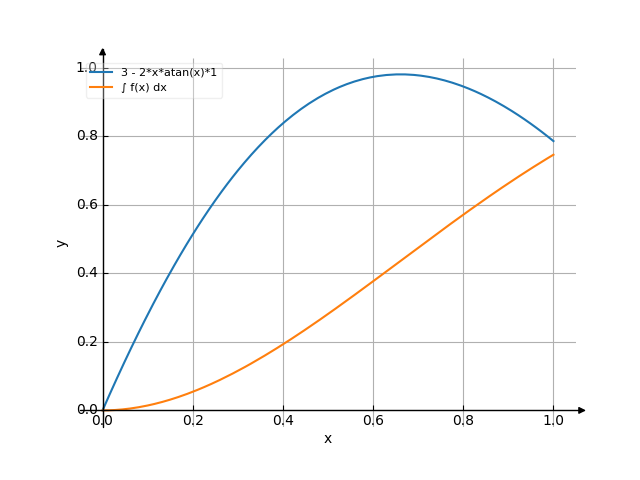Integral of (3-2x)*arctg(x)dx dx
The solution
Detail solution
-
There are multiple ways to do this integral.
Method #1
-
Rewrite the integrand:
(3−2x)atan(x)1=−2xatan(x)+3atan(x)
-
Integrate term-by-term:
-
The integral of a constant times a function is the constant times the integral of the function:
∫(−2xatan(x))dx=−2∫xatan(x)dx
-
Use integration by parts:
∫udv=uv−∫vdu
Let u(x)=atan(x) and let dv(x)=x.
Then du(x)=x2+11.
To find v(x):
-
The integral of xn is n+1xn+1 when n=−1:
∫xdx=2x2
Now evaluate the sub-integral.
-
The integral of a constant times a function is the constant times the integral of the function:
∫2(x2+1)x2dx=2∫x2+1x2dx
-
Rewrite the integrand:
x2+1x2=1−x2+11
-
Integrate term-by-term:
-
The integral of a constant is the constant times the variable of integration:
∫1dx=x
-
The integral of a constant times a function is the constant times the integral of the function:
∫(−x2+11)dx=−∫x2+11dx
-
The integral of x2+11 is atan(x).
So, the result is: −atan(x)
The result is: x−atan(x)
So, the result is: 2x−2atan(x)
So, the result is: −x2atan(x)+x−atan(x)
-
The integral of a constant times a function is the constant times the integral of the function:
∫3atan(x)dx=3∫atan(x)dx
-
Use integration by parts:
∫udv=uv−∫vdu
Let u(x)=atan(x) and let dv(x)=1.
Then du(x)=x2+11.
To find v(x):
-
The integral of a constant is the constant times the variable of integration:
∫1dx=x
Now evaluate the sub-integral.
-
The integral of a constant times a function is the constant times the integral of the function:
∫x2+1xdx=2∫x2+12xdx
-
Let u=x2+1.
Then let du=2xdx and substitute 2du:
∫2u1du
-
The integral of u1 is log(u).
Now substitute u back in:
log(x2+1)
So, the result is: 2log(x2+1)
So, the result is: 3xatan(x)−23log(x2+1)
The result is: −x2atan(x)+3xatan(x)+x−23log(x2+1)−atan(x)
Method #2
-
Use integration by parts:
∫udv=uv−∫vdu
Let u(x)=atan(x) and let dv(x)=3−2x.
Then du(x)=x2+11.
To find v(x):
-
Integrate term-by-term:
-
The integral of a constant is the constant times the variable of integration:
∫3dx=3x
-
The integral of a constant times a function is the constant times the integral of the function:
∫(−2x)dx=−2∫xdx
-
The integral of xn is n+1xn+1 when n=−1:
∫xdx=2x2
So, the result is: −x2
The result is: −x2+3x
Now evaluate the sub-integral.
-
Rewrite the integrand:
x2+1−x2+3x=x2+13x+1−1
-
Integrate term-by-term:
-
Rewrite the integrand:
x2+13x+1=x2+13x+x2+11
-
Integrate term-by-term:
-
The integral of a constant times a function is the constant times the integral of the function:
∫x2+13xdx=23∫x2+12xdx
-
Let u=x2+1.
Then let du=2xdx and substitute 23du:
∫2u3du
-
The integral of u1 is log(u).
Now substitute u back in:
log(x2+1)
So, the result is: 23log(x2+1)
-
The integral of x2+11 is atan(x).
The result is: 23log(x2+1)+atan(x)
-
The integral of a constant is the constant times the variable of integration:
∫(−1)dx=−x
The result is: −x+23log(x2+1)+atan(x)
Method #3
-
Rewrite the integrand:
(3−2x)atan(x)1=−2xatan(x)+3atan(x)
-
Integrate term-by-term:
-
The integral of a constant times a function is the constant times the integral of the function:
∫(−2xatan(x))dx=−2∫xatan(x)dx
-
Use integration by parts:
∫udv=uv−∫vdu
Let u(x)=atan(x) and let dv(x)=x.
Then du(x)=x2+11.
To find v(x):
-
The integral of xn is n+1xn+1 when n=−1:
∫xdx=2x2
Now evaluate the sub-integral.
-
The integral of a constant times a function is the constant times the integral of the function:
∫2(x2+1)x2dx=2∫x2+1x2dx
-
Rewrite the integrand:
x2+1x2=1−x2+11
-
Integrate term-by-term:
-
The integral of a constant is the constant times the variable of integration:
∫1dx=x
-
The integral of a constant times a function is the constant times the integral of the function:
∫(−x2+11)dx=−∫x2+11dx
-
The integral of x2+11 is atan(x).
So, the result is: −atan(x)
The result is: x−atan(x)
So, the result is: 2x−2atan(x)
So, the result is: −x2atan(x)+x−atan(x)
-
The integral of a constant times a function is the constant times the integral of the function:
∫3atan(x)dx=3∫atan(x)dx
-
Use integration by parts:
∫udv=uv−∫vdu
Let u(x)=atan(x) and let dv(x)=1.
Then du(x)=x2+11.
To find v(x):
-
The integral of a constant is the constant times the variable of integration:
∫1dx=x
Now evaluate the sub-integral.
-
The integral of a constant times a function is the constant times the integral of the function:
∫x2+1xdx=2∫x2+12xdx
-
Let u=x2+1.
Then let du=2xdx and substitute 2du:
∫2u1du
-
The integral of u1 is log(u).
Now substitute u back in:
log(x2+1)
So, the result is: 2log(x2+1)
So, the result is: 3xatan(x)−23log(x2+1)
The result is: −x2atan(x)+3xatan(x)+x−23log(x2+1)−atan(x)
-
Add the constant of integration:
−x2atan(x)+3xatan(x)+x−23log(x2+1)−atan(x)+constant
The answer is:
−x2atan(x)+3xatan(x)+x−23log(x2+1)−atan(x)+constant
The answer (Indefinite)
[src]
/ / 2\
| 3*log\1 + x / 2
| (3 - 2*x)*atan(x)*1 dx = C + x - atan(x) - ------------- - x *atan(x) + 3*x*atan(x)
| 2
/
∫(3−2x)atan(x)1dx=C−x2atan(x)+3xatan(x)+x−23log(x2+1)−atan(x)
The graph
3*log(2) pi
1 - -------- + --
2 4
−23log(2)+4π+1
=
3*log(2) pi
1 - -------- + --
2 4
−23log(2)+4π+1
Use the examples entering the upper and lower limits of integration.


![Find the integral of y = f(x) = (3-2x)*arctg(x)dx ((3 minus 2x) multiply by arctg(x)dx) - with detailed solution [THERE'S THE ANSWER!] (3-2x)*arctg(x)dx](/media/krcore-image-pods/176/hash/indefinite/a/e3/c45f60827006f62ac7f41ca6a6e3b.png)
 Integral of 6x^2
Integral of 6x^2
 Integral of x/(1+x²)
Integral of x/(1+x²)
 Integral of e^(x/2)
Integral of e^(x/2)
 Integral of e^(2*x)*sin(x)
Integral of e^(2*x)*sin(x)